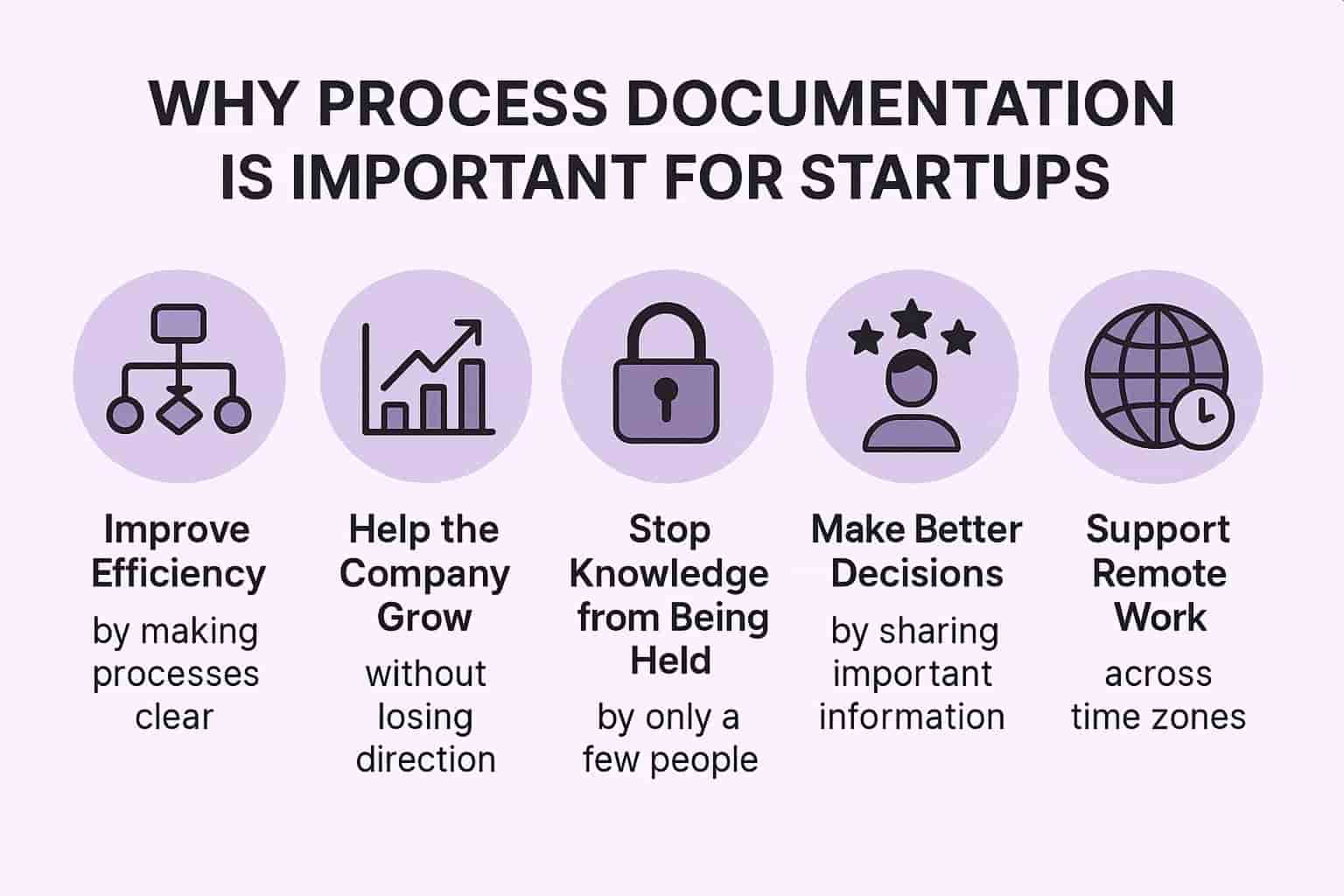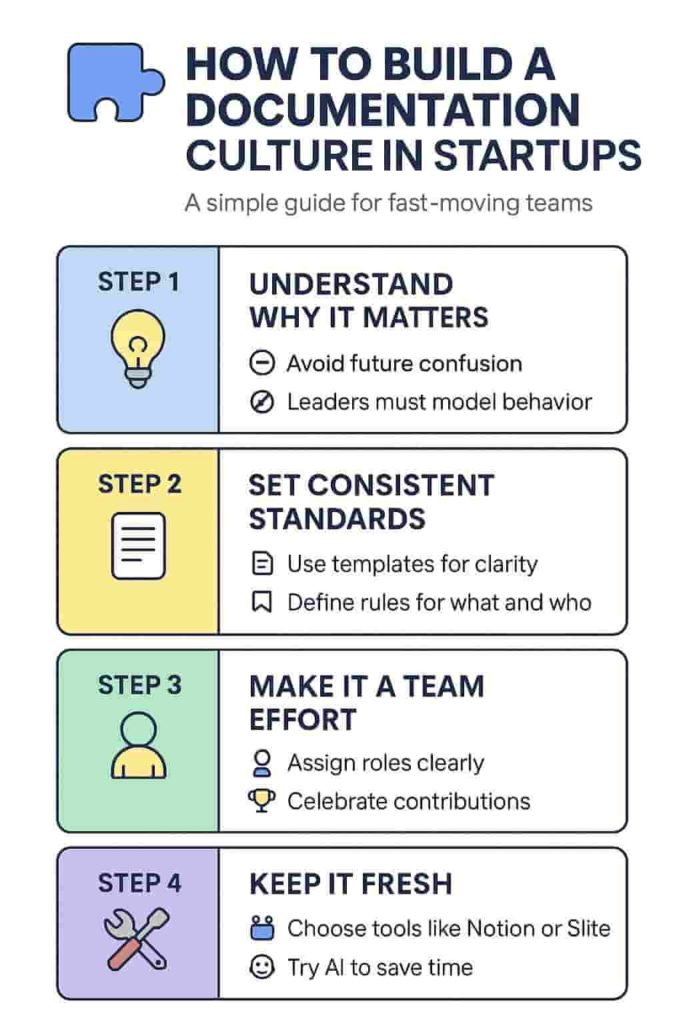In fast-moving, remote-first teams, decisions happen in DMs, updates live in people’s heads, and onboarding often starts with, “Let me find that thread for you.” It works—until it doesn’t. When time zones don’t overlap and everyone’s moving quickly, the absence of clear documentation can quietly erode team clarity, consistency, and momentum. That’s why investing in a culture of documentation isn’t about slowing things down; it’s about protecting speed. It’s how teams stay aligned across time zones, reduce repeat questions, and retain knowledge long after a handoff or hand-raise. From documenting HR processes to creating a healthy performance tracking culture and improving everyday process hygiene, strong documentation makes async work scalable.
This post explores how to build a documentation-first mindset that sticks, without piling on bureaucracy or killing momentum.
What Is Documentation Culture?
A documentation culture is more than just having a wiki or a folder of files; it’s a shared mindset that values clear, accessible, and up-to-date information as a core part of how the team works. It means everyone understands that knowledge isn’t private or buried in chat logs, but a collective asset that powers decision-making, onboarding, and daily execution.
In a documentation culture, writing things down isn’t an afterthought or a chore – it’s baked into workflows and communication habits. This culture helps reduce confusion, cut down on repeated questions, and unlocks asynchronous collaboration, which is essential when teams are spread across time zones.
Building this culture involves:
- Encouraging lightweight, just-in-time documentation over lengthy, perfect manuals
- Empowering team members to add, update, and reference docs as part of their day-to-day
- Designing tools and workflows that make documentation easy, discoverable, and valuable
When documentation becomes part of the team’s rhythm rather than an external burden, it acts as a force multiplier, helping fast-moving teams scale without losing clarity.
Why Process Documentation Is Important for Startups
Startups move quickly and need to adapt often. Without clear documentation, fast growth can cause confusion and slow down progress. Process documentation is essential to keep operations running smoothly and to support growth. Here are the main reasons why it matters:
Improve Efficiency by Making Processes Clear
When everyone knows the exact steps to follow for common tasks, such as hiring, launching products, or customer support, they spend less time asking questions and more time doing their work. Clear documentation helps prevent mistakes and avoids doing the same work twice.
Help the Company Grow Without Losing Direction
As startups grow, new team members join and roles change. If there are no clear guides, these changes can create confusion and slow the team down. Well-written process documents keep everyone on the same page and make onboarding faster and easier.
Stop Knowledge from Being Held by Only a Few People
In fast-moving teams, important information can live only in some team members’ minds or private chats. This can cause problems when those people are busy or leave. Documentation shares knowledge openly so the whole team can access it anytime.
Make Better Decisions by Sharing Important Information
Good decisions depend on good information. When the team has access to clear process documents and explanations of why things are done a certain way, they can make faster and smarter decisions without repeating past mistakes.
Encourage Continuous Learning and Improvement
Documentation should not be fixed and forgotten. When teams regularly update and improve their process documents, they create a culture of learning and growth. This helps make workflows better over time.
Support Remote and Asynchronous Work
For teams working across different time zones, it is hard to always be online together. Documentation acts as a reference that team members can use anytime, reducing the need for constant meetings and helping everyone stay aligned.

Why Documentation Feels Like a Drag (and How to Rethink It)
It’s Not Laziness—It’s the Way Work Happens
In high-velocity teams, people are rewarded for action: shipping features, solving bugs, closing tickets, and moving the business forward. Documentation, on the other hand, rarely feels urgent, and when no one asks for it, it gets deprioritized. Multiply that across time zones and functions, and you end up with a team that runs on memory and Slack history.
But the cost of skipping documentation is subtle and cumulative. Onboarding takes longer. Questions get asked again and again. Decisions get reversed because the context was lost. And when key people leave or go on PTO, work stalls because the “how” and “why” behind core processes disappear with them.
Traditional Documentation Doesn’t Fit Fast Teams
Most fast-paced startups reject heavyweight documentation systems for good reason—they feel like a leftover from corporate IT departments. Long-form pages, rigid templates, and knowledge silos don’t work when your team is async and constantly iterating.
That’s why documentation needs a reset. Instead of treating it as an archive or a one-off project, think of it as infrastructure. Just like CI/CD pipelines help developers ship code faster, lightweight documentation helps teams scale knowledge without slowing down. Done right, it supports autonomy, reduces back-and-forth, and creates the clarity people need to move fast without tripping over each other.
Reframe It as an Operational Lever, Not a Tax
Documentation isn’t about checking boxes; it’s about enabling better decisions and fewer bottlenecks. When someone documents a hiring process, a sprint ritual, or a tool workflow, they’re not just creating a record. They’re improving consistency, reducing interruptions, and giving others the ability to contribute without waiting for a reply.
Framed this way, documenting HR processes, sharing meeting-free decision logs, or even logging a post-mortem becomes an investment in team performance, not a bureaucratic burden. This mindset shift is what sets the foundation for a strong, async-ready performance tracking culture.
Benefits of Building Documentation as a Culture
Making documentation part of a team’s daily habits brings long-term value. It is not only about writing things down, it is about creating a mindset where clarity, transparency, and shared learning are the default.
Improve Team Alignment Across Locations and Roles
When documentation is part of the culture, everyone, regardless of time zone or role, can understand how things work and why decisions were made. This keeps teams aligned without needing constant meetings or check-ins.
Reduce Repetition and Unnecessary Questions
If every new team member asks the same questions during onboarding, that is a sign that something needs to be written down. Cultural documentation saves time by answering common questions up front, freeing up senior team members to focus on deeper work.
Build Trust by Making Information Easy to Access
Open documentation shows that a team trusts each other with context, not just instructions. It removes guesswork and gives everyone the same information, which creates a stronger sense of ownership and accountability.
Support Better Onboarding and Role Transitions
When documentation is embedded in the culture, onboarding does not depend on one person being available. New hires can learn at their own pace with confidence, and role transitions happen more smoothly when knowledge is written and shared.
Make Feedback and Iteration Easier
A living culture of documentation allows processes and decisions to be reviewed, discussed, and improved over time. Instead of relying on memory or assumptions, teams can reflect on what is written and suggest changes that benefit everyone.
Create a Strong Foundation for Scaling
As a company grows, what worked for five people will not always work for fifty. Documentation helps scale operations without needing to reinvent processes each time a new team is added or a new office opens.
Steps to Build a Strong Culture of Documentation in Startups
Building a documentation habit across a startup does not happen overnight. It takes thoughtful planning, leadership support, and the right tools to make it stick. Here is a step-by-step guide to help early-stage teams turn documentation into a core strength.

Step 1: Understand Why Documentation Matters
Before changing behavior, a team needs to see the value in doing so.
Avoid Bottlenecks by Writing Things Down Early
Startups that take the time to document key decisions, workflows, and processes early on avoid confusion as they grow. Having documentation from day one can save hours of rework and keep operations smooth even as teams expand quickly.
Get Leadership to Lead by Example
If founders and managers model documentation themselves, it sends a strong message. When leadership treats documentation as essential—not optional, it encourages others to follow their lead and make it part of daily work.
Step 2: Create Consistent Standards for Documentation
Clear standards remove friction and make documentation feel less like a chore.
Use Simple Templates to Save Time
Pre-built templates help teams capture the right information consistently. Whether documenting an onboarding process or a sprint retrospective, templates reduce the effort and raise the quality of what gets written.
Set Clear Rules for What, Who, and When
Decide which types of work should always be documented (e.g., hiring processes, team rituals, product decisions), who is responsible, and how often updates are needed. These ground rules make documentation easier to maintain over time.
Step 3: Make Documentation a Team Activity
When everyone contributes, documentation becomes a shared asset, not a burden.
Assign Roles and Make Ownership Clear
Define who will own different parts of the documentation, such as who updates policies, owns onboarding materials, or captures meeting notes. Shared responsibility ensures documentation does not fall through the cracks.
Encourage Contributions with Recognition
Thank and spotlight team members who keep documentation fresh and helpful. Whether it is public shoutouts, team leaderboards, or small rewards, positive reinforcement builds momentum and normalizes participation.
Step 4: Keep Documentation Alive and Useful
Documentation should adapt as the company evolves—it should never sit still.
Review and Refresh Regularly
Build a rhythm for reviewing and updating documents. Outdated content can lead to mistakes or misunderstandings. A quarterly or biannual review cycle can help keep things current and relevant.
Ask for Feedback and Make Improvements
Check in with team members about what is working and what is not. If parts of your documentation are hard to follow or missing context, use that input to revise and improve. Treat documentation like a product—always open to iteration.
Step 5: Use the Right Tools to Make It Easy
Documentation should be easy to write, find, and update. The right tools make a big difference.
Try Tools Like Slite, Notion, or Document360
These platforms are built for fast-moving teams and offer features like easy navigation, real-time editing, and permissions control. They make it simple for everyone to contribute without needing to be technical.
Explore Automation and AI-Powered Help
Modern documentation tools can now surface suggestions, highlight outdated content, and even summarize long threads. AI support helps make writing and maintaining documentation less time-consuming and more accurate.
Tip: For process-based documentation that lives inside your communication tools, AttendanceBot helps automate and log actions like leave approvals, shift assignments, and check-ins, so teams don’t need a separate handbook to understand how these workflows function.
Conclusion
Building a documentation culture is not about creating red tape, it is about creating clarity. In a world where teams rarely share the same room or time zone, written processes are what hold everything together. The goal is not to document everything, but to document the things that matter consistently, collaboratively, and with purpose. Start small, stay intentional, and let documentation become a natural part of how your team works, not an extra task they avoid.



